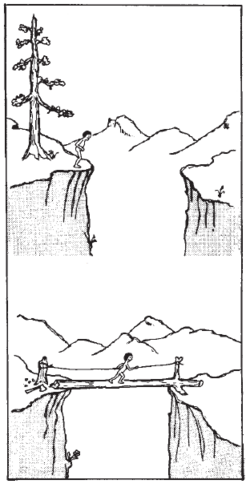Hesperian Health Guides
Child Development
HealthWiki > Disabled Village Children > Chapter 34: Child Development and Developmental Delay > Child Development
| A child's abilities develop in a particular order, one upon the other, like building blocks. |  |
In order to know how well a child is developing and in which areas she may need help, we can compare her development with that of other children.
An understanding of child development can guide us in planning activities that will help children with disabilities progress.
Every child develops in 3 main areas: physical
(body), mental (mind), and social (communication and relating to other people). In each area, she develops skills step by step in a certain order. During the first year of life, a baby usually gains more and more control of her body.
Body control develops progressively from the head down:

Before she can begin to walk, a baby needs to go through a series of developmental stages, or levels. First, she has to be able to hold up her head and see what is around her. This encourages her to use her arms and hands so that she can then learn to lift herself to sit. While sitting, she begins to reach, lean, and twist. All this helps her to develop balance and to shift her weight from side to side—skills she will soon need for standing and walking. Usually, the stimulation that a child needs to advance through these stages comes from ordinary day-to-day interaction with people and things.
However, a child who has a disability may need help to keep progressing. Notice that in the above example, the child’s ability to see makes her want to reach for things and explore. Seeing stimulates her to try to learn and do more. If a child cannot see, this basic part of early stimulation is lacking. To prevent her from falling behind, we must look for other ways to encourage her to learn and do things. We can do this through touch and sound, adapting the type of stimulation we use to the child’s particular stage of development. For example, if a baby cannot see:
| From the first we should hold her and speak to her a lot. Help her to reach out to touch and feel different things. | Later, we can encourage her to lift and turn her head, and then reach out, toward different sounds. | When she begins to sit, again we can help her to recognize different sounds and reach toward them. | When she begins to walk we can help her find her way with guide poles, and in other ways. |
 Good girl. Touch mama's face.
Find the rattle. Good girl!
meow meow
cluck cluck | |||
For more ways to help a child who cannot see well, see Chapter 30.
It is important for parents to realize that a child develops control and use of her body in a certain order:
This is true even for an older child. Often parents of an older child who is delayed will try to help her learn more advanced skills (which other children her age are learning) before she is ready. This often leads to disappointment and frustration both for parents and child.
For example, Nina is a 3-year-old girl with cerebral palsy. She still has trouble holding up her head or sitting without falling over.

 |
| stepping reflex in a 1-month-old baby |
However, her mother is sure she is “almost ready to walk.” Several times each day she holds Nina in a standing position and moves her forward, so that her feet take stiff, jerky steps on tiptoe. Her mother does not know that this stepping is an early reflex normally only seen in young babies. It means that in some ways Nina’s development is still at the level of a 1-month to 3-month old baby. She is not yet ready to walk. Making her take steps will only keep active the early reflex which she needs to lose in order to learn to really walk.
We must help Nina’s mother realize that Nina first needs help with other important developmental steps before she will be ready to learn to walk. To help her develop further, her mother will need to:
- Figure out what developmental age or stage the child is at.
- Decide what are the next steps forward, so that the child can build new skills on the ones she has now, in the same order in which a child usually develops.

To do these things, Nina’s mother should first observe the child carefully. In each area of development, she notes the different things Nina can do, the things she cannot do yet, and the things she is just beginning or trying to do, but still has trouble with. Next, her mother compares what Nina can and cannot do with what other children Nina’s age can do. She can then decide at what level her child is at in each area of development, and what are the next steps to work toward.
The Chart on Typical Child Development
The downloadable Child Development Chart shows some of the steps or “milestones” of typical child development. You can use it to figure out where a child is in her development, and to plan the next steps that she needs help with.
You can download a .pdf copy of the Child Development Chart here:
How to use the Child Development Chart
The downloadable copy of the chart can be used to:
- find and record a child’s developmental level.
- plan the next developmental steps or activities with which we can help the child, and
- record in which areas the child is progressing, and how much.
Let us suppose that a village health worker wants to help Nina’s mother figure out what she needs to do next to help her 3-year-old daughter develop early abilities. Together they look at the chart.

First they put a circle around each of the things that Nina can do. Since she still has trouble holding her head up, they put a circle here. Nina needs help to roll from her belly to her back, so they put a circle that goes part way around “rolls belly to back.”
After they circle Nina’s level in each area of development, they can see that in her general body movements and control, Nina is still at the level of a 2- to 4-month-old baby. Her hand control is at about 6 months. Her seeing and hearing seem about typical for her age, and her mental development is at about 2 years.
Then they put a square around the next developmental step after each circle. The squares show which developmental steps Nina now needs help with. Because Nina’s difficulty with head control is holding her back in other areas, they decide to work mostly with this, and also to help her with rolling and twisting her body. Perhaps they can begin to work with sitting and creeping, but probably she will not progress much with these until she gets better head control. The use of her hands is still somewhat behind for her age, but this may partly be because of her difficulty with head control. So they decide to have her sit for short periods each day in a special seat. With her head supported in a good position, they can give her games and things to do to help her develop better use of her hands. But, they are careful not to keep her head supported for long, because that will not help her to learn to support it herself. Also, they are careful to provide only the least amount of support needed to give her better control of other parts of her body. They will reduce the support as her control improves.
Because Nina’s eyes, ears, mind, and speech seem to be developing fairly well, these will probably be what she learns to use best as she grows older. Therefore, her parents decide to do all they can to help her improve these skills. They use pictures, songs, stories, play, and a lot of stimulation to help her develop her mind. But they try to remember that she is still only 3 years old. They must not push her too much. Sometimes it is better to help her gain skill and confidence in only 1 or 2 areas at a time.
To use the Child Development Chart for recording a child’s progress, every month or two you can add new circles to the chart. Use a different colored ink each time, and mark the date in the same color. Then add new squares to determine the developmental steps that are next in line.


